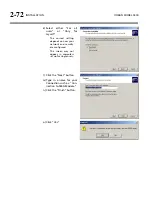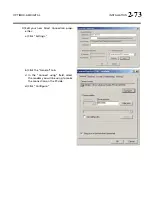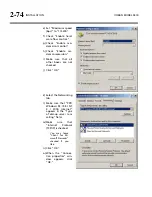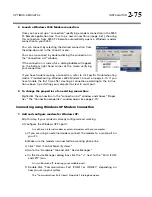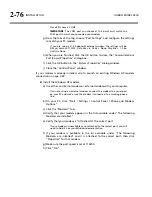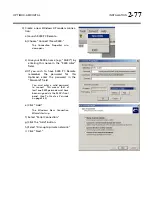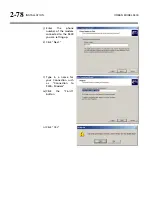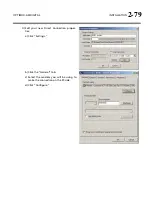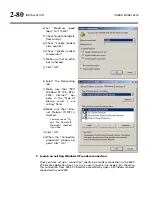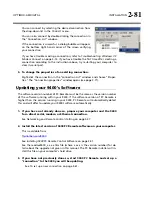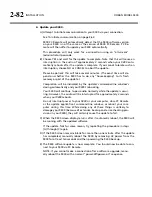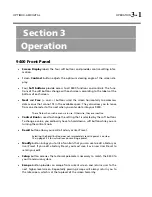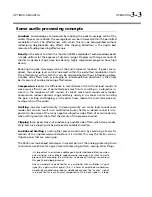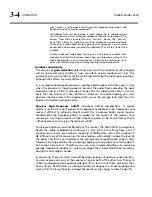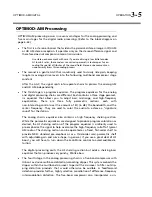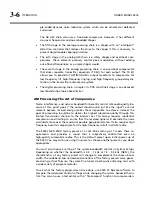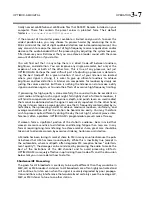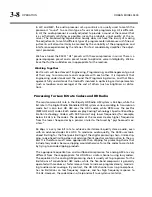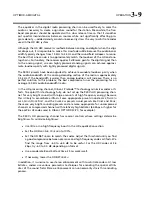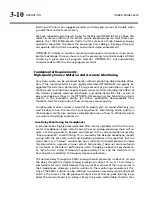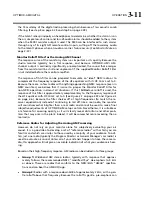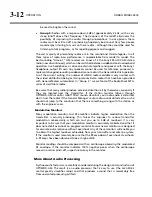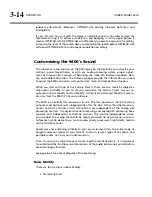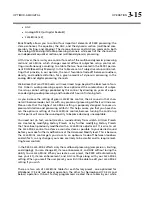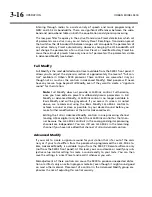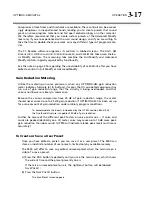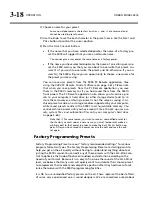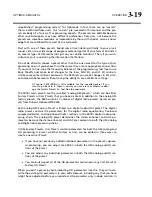
3-4
OPERATION ORBAN
MODEL
9400
rate “carrier” and the peak limiting process produces modulation side-
bands around each Fourier component.
Considered from this perspective, a hard clipper has a wideband gain
control signal and thus introduces sidebands that are far removed in fre-
quency from their associated Fourier “carriers.” Hence, the “carriers”
have little ability to mask the resulting sidebands psychoacoustically.
Conversely, a look-ahead limiter’s gain control signal has a much lower
bandwidth and produces modulation sidebands that are less likely to be
audible.
Simple wideband look-ahead limiting can still produce audible inter-
modulation distortion between heavy bass and midrange material. The
look-ahead limiter in your Optimod uses sophisticated techniques to re-
duce such IM distortion without compromising loudness capability.
Loudness and density
The amount of
gain reduction
determines how much the loudness of soft passages
will be increased (and, therefore, how consistent overall loudness will be). The
automatic gain control (AGC) and the multiband limiter both provide gain reduction,
although their effects are quite different.
In a competently-designed processor, audibly objectionable distortion occurs only
when the processor is clipping peaks to prevent the audio from exceeding the peak
modulation limits of the transmission channel. The less clipping that occurs, the less
likely that the listener will hear distortion. However, to reduce clipping, you must
decrease the drive level to the clipper, which causes the average level (and thus, the
loudness) to decrease proportionally.
Receiver high frequency rolloff
introduces further complications. A typical
receiver’s severe HF rolloff reduces the headroom available at high frequencies and
makes it difficult to achieve a bright sound. This is because bright sound requires
considerable high frequency power to appear at the output of the receiver, thus
requiring a very large amount of high frequency power to be transmitted so that a
sufficient amount will survive the receiver’s rolloff.
To increase brightness and intelligibility at the receiver, the 9400’s NRSC pre-emphasis
boosts the treble at 6dB/octave starting at 2.1 kHz.
HF
C
URVE
settings from
0
to
10
produce more severe pre-emphasis, boosting at 18dB/octave with 2 kHz up about 3
dB. Without very artful processing, this pre-emphasis will radically increase the level of
the peaks and force you to decrease the average level proportionally. Orban's high
frequency limiting and distortion-canceling clipping systems greatly ease this trade-off,
but cannot eliminate it. Therefore, you can only increase brightness by reducing
average modulation (loudness)
unless you accept the increased distortion caused by
driving the final clippers harder.
In processing, there is a
direct trade-off
between loudness, brightness, and distortion.
You can improve one only at the expense of one or both of the other two. Thanks to
Orban's psychoacoustically-optimized designs, this is less true of Orban processors than
of any others. Nevertheless, all intelligent processor designers must acknowledge and
work within the laws of physics and psychoacoustics as they apply to these trade-offs.
Summary of Contents for Optimod-AM 9400
Page 1: ...Operating Manual OPTIMOD AM 9400 Digital Audio Processor Version 1 2 Software...
Page 7: ...Operating Manual OPTIMOD AM 9400 Digital Audio Processor Version 1 2 Software...
Page 52: ......
Page 204: ......
Page 232: ......
Page 260: ......
Page 261: ...OPTIMOD AM DIGITAL TECHNICAL DATA 6 29...
Page 267: ...OPTIMOD AM DIGITAL TECHNICAL DATA 6 35 CPU Module...
Page 273: ...OPTIMOD AM DIGITAL TECHNICAL DATA 6 41 RS232 BOARD PARTS LOCATOR...
Page 275: ...OPTIMOD AM DIGITAL TECHNICAL DATA 6 43 8300 POWER SUPPLY PARTS LOCATOR...
Page 284: ...6 52 TECHNICAL DATA ORBAN MODEL 9400 DSP BOARD PARTS LOCATOR DRAWING 32170 000 14...
Page 292: ...6 60 TECHNICAL DATA ORBAN MODEL 9400 DISPLAY BOARD PARTS LOCATOR...
Page 293: ...OPTIMOD AM DIGITAL TECHNICAL DATA 6 61 DISPLAY BOARD...

